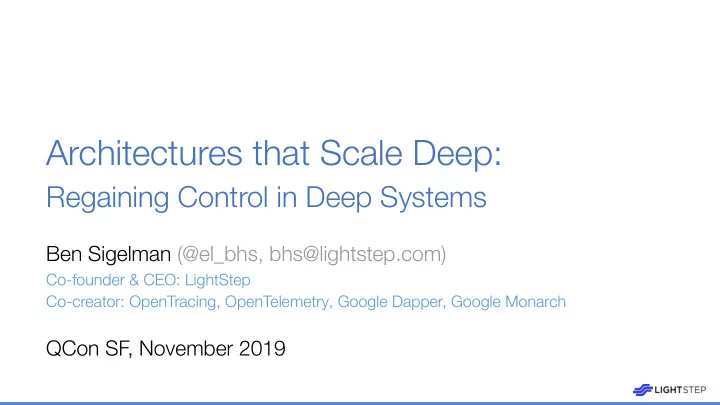

Architectures that Scale Deep: Regaining Control in Deep Systems Ben Sigelman (@el_bhs, bhs@lightstep.com) Co-founder & CEO: LightStep Co-creator: OpenTracing, OpenTelemetry, Google Dapper, Google Monarch QCon SF, November 2019
Part I Scaling, and Deep Systems
What is scale, anyway?
Scaling wide
Scaling wide
Scaling wide
Scaling wide
Scaling wide
Scaling deep
Scaling deep
Scaling deep
Scaling deep
Scaling deep
How does this look for software?
Software: Scaling wide
Software: Scaling deep
How do real-world systems look?
Microservices at scale aren’t just wide systems , they’re deep systems
Deep Systems Deep Systems Architectures with ≥ 4 layers of Architectures with ≥ 4 layers of independently operated services independently operated services (including external/cloud dependencies) (including external/cloud dependencies)
What do deep systems sound like?
What do deep systems sound like? “Don’t deploy on Fridays”
What do deep systems sound like? “Where’s Chris?! I’m dealing with a P0 and they’re the only one who knows how to debug this.”
What do deep systems sound like? “It can’t be our fault, our dashboard says we’re healthy”
What do deep systems sound like? “Kafka is on fire”
What do deep systems sound like? “I need 100% availability from your team. One hundred percent .”
What do deep systems sound like? “I didn’t know I depended on that region”
What do deep systems sound like? “That was on a dashboard but I can’t find it”
What do deep systems sound like? Lots of challenges: - People-management - Security - Multi-tenancy - “Big-customer” success - Performance - Observability
Part II Control Theory: TL;DR Edition
Why do we care so much about observability , anyway?
Inputs Outputs A System … and its state vector,
Observability Inputs Outputs A System … and its state vector, How well can you infer internal state using only the outputs ?
Controllability Inputs Outputs A System … and its state vector, How well can you control internal state using only the inputs ?
Controllability is the dual of Observability
Controllability is the dual of Observability
Part III What Deep Systems Mean for Observability
Pure Monoliths developers per service Deep Systems Architectural evolution # of services
Stress (n): responsibility without control Stress what you can control what you are responsible for
Observability: Shrink This Gap
Mental models A System
Managing Deep Systems Services must have SLOs (“Service Level Objectives”: latency, errors, etc) For effective service management, only three things matter: 0. Releasing service functionality 1. Gradually improving SLOs 2. Rapidly restoring SLOs In a deep system, we must control the entire “triangle” to maintain our SLOs
There’s that word again… Controllability == Observability Controllability == Observability
Observability: “The Conventional Wisdom” Observing microservices is hard Google and Facebook solved this (right???) They used Metrics, Logging, and Distributed Tracing… … So we should, too.
3 Pillars, 3 Experiences Metrics Logs Traces
Three Pillars? Three Pillars? Two giant pipes… Metrics Without Traces: Cognitive Load ≈ O( depth 2 ) Logs
Three Pillars? Three Pillars? Two giant pipes… Metrics Logs
Two giant pipes… Metrics Without Traces: Cognitive Load ≈ O( depth 2 ) Logs
Traces
Traces provide Context
Traces provide Context And context rules out invalid hypotheses
Two giant pipes and a filter Metrics Context (from traces) Logs
Context reduces cognitive load Relevant Metrics Context (from traces) Relevant Logs With Traces: Cognitive Load ≈ O( depth )
Observability: Shrink This Gap
Let’s Review
Microservices don’t just scale wide, they scale deep Recognize deep systems
Stress (n): responsibility without control Stress what you can control what you are responsible for
“Controllability” (of SLOs) depends on observability
“The Three Pillars of Observability” is a lousy metaphor … and traces are not sprinkles
Tracing can reduce cognitive load from O( depth 2 ) to O( depth )
Tracing is the backbone of simple observability in deep systems
Thank You Play with LightStep, Feedback always for free, anytime: welcome: (no email address required!) twitter → @el_bhs lightstep.com/play the emails → bhs@lightstep.com
Recommend
More recommend